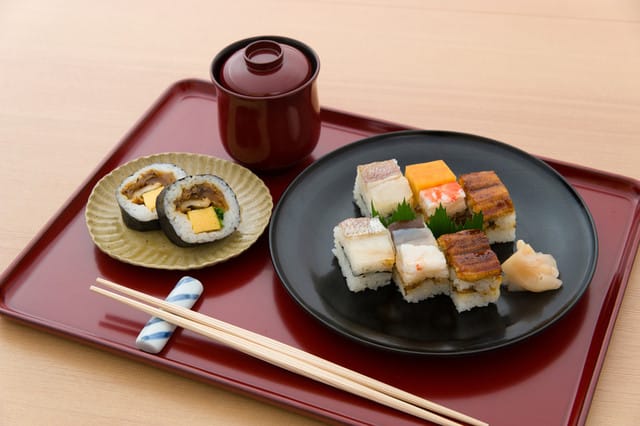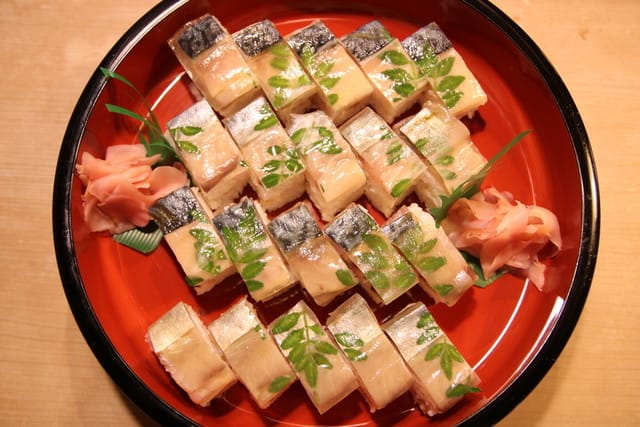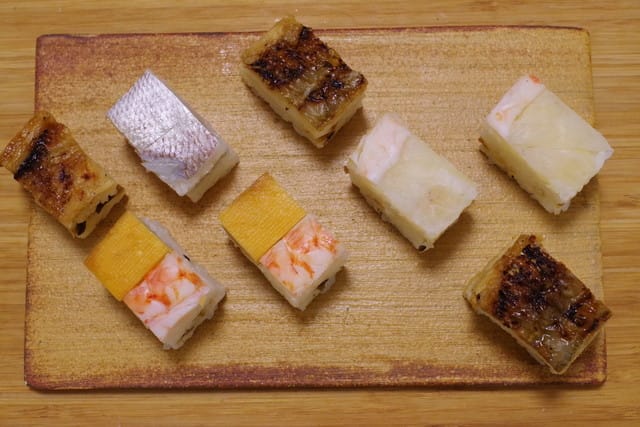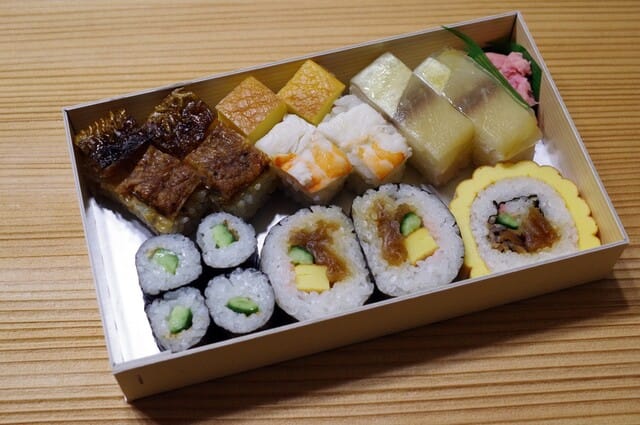Among globally renowned Japanese dishes like sukiyaki, tempura, and tonkatsu, sushi stands out for its popularity due to its health benefits. With sushi chain restaurants expanding overseas, any foreign Japan enthusiast has likely tried it at least once.
Among sushi varieties, the popular nigiri sushi showcases the skills of experienced chefs. It's said that becoming an independent sushi chef takes "3 years for rice cooking, 5 years for seasoning, and a lifetime for hand-forming," requiring about 10 years to become independent.
Besides nigiri, sushi comes in various forms like maki (rolled sushi), oshi (pressed sushi), and chirashi (scattered sushi). Maki and chirashi are easy to make at home, and I often prepare them myself.
Interestingly, sushi flavors and preparation methods vary by region. In this article, we'll introduce the characteristics of "Hakozushi," a unique type of sushi.
About Japanese Sushi
Sushi, a staple of Japanese cuisine, comes in various forms including nigiri, maki, oshi, and chirashi. Its light, easy-to-eat, and healthy nature makes it popular among Japanese people. The wide range of establishments, from affordable everyday spots to high-end restaurants perfect for special occasions, adds to its appeal. Did you know that sushi has regional characteristics?
- Hokkaido: Sour vinegared rice with almost no sugar
- Northern Tohoku and Hokuriku: Strongly acidic vinegared rice using fermented rice
- Kanto and Nagano: Vinegared rice with moderate sweetness using sugar
- Tokai, Kinki, and Chugoku: Sweet vinegared rice using equal parts sugar and vinegar
- Shikoku: Sweet vinegared rice using more sugar than vinegar, fish stock, and yuzu juice
- Kyushu: Very sweet vinegared rice using more sugar than vinegar
- Okinawa: Spicy vinegared rice using almost only vinegar
The taste subtly differs by region. In this article, we'll introduce Hakozushi, an Osaka specialty characterized by sweet vinegared rice.
What is Hakozushi?
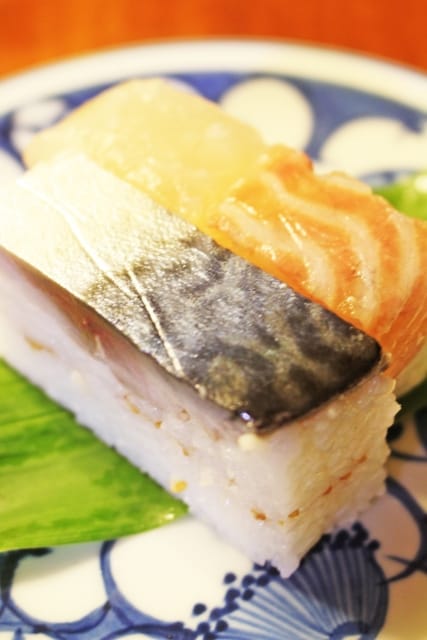
Hakozushi, also known as oshizushi or Osaka sushi, is one of Osaka Prefecture's local dishes selected as part of the 100 Rural Cuisine selections by the Ministry of Agriculture, Forestry and Fisheries. It's made by placing sweet vinegared rice in a square wooden box, then layering ingredients like shrimp, sea bream, and conger eel, pressing them together.
It originated in the Meiji era in Osaka, initially as pressed sushi using readily available ingredients like horse mackerel and mackerel. As higher-grade ingredients like sea bream and conger eel were incorporated, it evolved into Hakozushi as a dish for entertaining guests.
Recently, some versions focus on visual appeal, resulting in artistic presentations. Another characteristic is its longer shelf life due to the use of pre-cooked ingredients.
Although the number of shops selling Hakozushi has decreased due to the time-consuming preparation process, it remains a popular choice for gifts and events in Osaka, preserving its traditional taste.
Characteristics of Osaka's Hakozushi
Hakozushi is a high-end version of pressed sushi using premium ingredients like sea bream, shrimp, and conger eel. It's sometimes called "two-sun-six-bu kaiseki." The sushi is neatly arranged in bite-sized pieces in a square wooden box.
While preparation methods vary slightly by shop, most Hakozushi consists of 2-4 layers of vinegared rice and ingredients. Sweet simmered shiitake mushrooms or kanpyo (dried gourd strips) are often placed between rice layers, adding depth to the flavor. The top layer typically features colorful ingredients like shrimp or egg, creating a visually appealing presentation.
I once received Hakozushi as a gift, and when I opened the lid, I couldn't help but exclaim, "How beautiful!"
Can Hakozushi be Made at Home?
Although Hakozushi requires advance preparation of vinegared rice and ingredients, it can be made at home. While traditionally prepared in a square wooden box, you can use a pound cake mold or milk carton as a substitute. Here's a simple explanation of the process:
1. Mix cooked rice with seasoned vinegar to make sushi rice, then let it cool
2. Line the container with plastic wrap and layer smoked salmon, scrambled eggs, or simmered conger eel without mixing
3. Cover with half the sushi rice, place a sheet of nori seaweed, add the remaining rice, and press firmly
4. Remove from the container with the plastic wrap and cut into desired sizes
The key is to cook the rice slightly harder than usual and make the vinegared rice sweeter. When I made it, using plastic wrap in the container made it easy to remove and cut. Try creating your original Hakozushi with your favorite ingredients.
Recommended Sushi Restaurants for Hakozushi in Osaka
Yoshino Sushi
source:Tabelog
Yoshino Sushi is a long-established sushi restaurant that has been featured in the Michelin Guide, offering the unchanged taste of Osaka sushi for over 170 years. It's popular among locals and tourists alike. Yoshino Sushi is recommended for its exquisite taste created through four key points:
- Live-grilled conger eel: Using natural conger eel about 30cm long, considered the most delicious, grilled plump with a secret sauce passed down since the restaurant's founding
- Shari (rice): Using hard rice from Western Japan, which becomes more flavorful as you chew and maintains its taste over time
- Simmered shiitake mushrooms: High-grade thick shiitake mushrooms from Kyushu, slowly cooked for 5 hours until tender
- Live small sea bream: Fresh small sea bream salted and marinated in vinegar overnight
The recommended menu item is Hakozushi. You can fully enjoy the carefully prepared live-grilled conger eel, thick omelet, and live small sea bream on top of the rice.
<Store Information>
- Address: 3-4-12 Awaji-machi, Chuo-ku, Osaka
- Closed: Saturdays, Sundays, and holidays
- Phone: 06-6231-7181
- Hours: 9:30-14:00
- Official website: https://www.yoshino-sushi.co.jp/
Abaraya
source:Tabelog
At Abaraya, you can enjoy sushi made with fresh fish from Kizu Market and side dishes that pair well with alcohol. The restaurant has tatami room private dining areas where you can relax without worrying about others. Enjoy carefully selected sake and exquisite dishes in a Japanese atmosphere with shoji doors and cushions.
At the counter seats, you can watch the chefs' skillful preparation up close for a live experience. The recommended menu item is the seasonal kaiseki course (4,400 yen including tax). It includes 6 dishes: appetizer, 4 kinds of sashimi, chawanmushi, sakura-mushi, 3 kinds of tempura with vegetables, and saba sushi, all featuring seasonal ingredients.
The signature mackerel sushi is available for 2,500 yen for a whole piece (20 pieces) or 1,300 yen for half (10 pieces).
<Store Information>
- Address: 2-14 Namba Sennichimae, Chuo-ku, Osaka
- Closed: Sundays and holidays
- Phone: 050-5593-7620
- Hours: 16:00-23:00
- Official website: https://abaraya-namba.gorp.jp/
Sushi Restaurants in Tokyo Serving Hakozushi
Hachiku
source:Tabelog
Hachiku, established in 1924, specializes in Osaka sushi and chakin-zushi (sushi rice wrapped in thin omelet). Besides these, they offer futomaki (thick rolled sushi), datemaki (futomaki with egg instead of nori), and kimi-zushi (sushi topped with sweetened egg yolk). All items can be ordered individually.
Hachiku offers 10 different assortments to suit your preferences, allowing you to choose your favorite combination.
- Chakin-zushi and Osaka sushi set for 1 person (1 chakin-zushi, 3 Osaka sushi, 2 futomaki): 1,620 yen
- Osaka sushi set for 1 person (6 Osaka sushi, 1 futomaki, 1 datemaki): 1,800 yen
- Chakin-zushi and Osaka sushi set for 1.5 persons (1 chakin-zushi, 6 Osaka sushi, 1 futomaki, 1 datemaki): 2,470 yen
About 10 options are available, including the above. The recommended menu item is the popular Osaka sushi set for 1.5 persons. While it looks compact, it's packed with vinegared rice and very filling! It's satisfying even for men.
<Store Information>
- Address: Hachiku Building 1F, 3-11 Yotsuya, Shinjuku-ku, Tokyo
- Closed: Wednesdays
- Phone: 03-3351-8989
- Hours: 10:00-17:00
- Official website: https://yotsuya-hachiku.co.jp/
Yachiho Sushi
source:Tabelog
Yachiho Sushi is a sushi specialty store that has been committed to handmade methods since its establishment in Sugamo in 1972. They offer a wide range of products from staples like Osaka sushi, inari, norimaki, and chakin, to seasonal limited items and pre-order products. They also have unique varieties like onion inari, navel orange inari, and basil inari, which can be purchased with a day's advance reservation.
The recommended Osaka sushi can be chosen from 10 different assortments. The popular "Sakura" set includes 7 types of sushi: shrimp, conger eel, battera, salmon, datemaki, futomaki, and inari, available for 1,400 yen. I visited soon after they relocated, and the shop has a clean feel that makes it easy to enter. The sushi displayed in the showcase is visually beautiful, and just choosing makes you excited.
<Store Information>
- Address: 4-3-28 Kudanshita-kita, Chiyoda-ku, Tokyo
- Closed: Mondays (Tuesday if Monday is a holiday)
- Phone: 03-6272-8466
- Hours: 10:00-17:30
- Official website: https://yachiho-sushi.com/
Conclusion
Sushi has many foreign fans and is often cited as a must-try meal when visiting Japan. Besides the representative nigiri sushi, there are also maki and oshi sushi, with Hakozushi being popular in Osaka.
Not only delicious, Hakozushi is visually appealing with a balanced arrangement of ingredients like conger eel, shrimp, and egg. Many pressed sushi specialty stores are long-established, continuing to preserve their original taste since their founding.
The preparation process, including lengthy pre-cooking, is time-consuming. Appreciating the craftsmen's skills while eating can make the experience even more enjoyable. Please try Hakozushi and immerse yourself in Japanese culture and a nostalgic atmosphere.

